中元节的来历及风俗中英文介绍
2024年中元节的真正来历介绍

2024 年中元节的真正来历介绍中元节的真正来历(介绍)中元节,是道教名称,民间世俗称为七月半,佛教则称为盂兰盆节。
节日习俗主要有祭祖、放河灯、祀亡魂、焚纸锭、祭祀土地等。
下面是我为大家整理的中元节的真正来历,仅供参考,喜爱可以保藏共享一下哟!中元节的由来这个节日源于早期的“七月半”农作丰收秋尝祭祖,“七月半”的产生可以追溯到上古的祖先崇拜与农事丰收时祭。
古时人们对于农事的丰收,常寄予于神灵的庇佑。
奉祀先祖在春夏秋冬皆有,但初秋的“秋尝”在其中非常重要。
秋天是收获的季节,人们实行向祖先亡灵献祭的仪式,把时令佳品先供神享,然后自己品尝这些劳动的果实,并祈祝来年的好收成。
中元节的传闻关于鬼节的来历,传闻地藏菩萨,他的母亲去世后来到阴曹地府,被关在牢房里少不得受十八层地狱的种种熬煎,地藏菩萨是个孝顺的女儿,看到母亲受罪心中不忍,在七月十五这天竟恂私情,让看管牢房的小鬼偷偷把牢门打开放他母亲出来,谁知这一开牢门没关系,牢房中的小鬼们蜂拥而出跑到人间为害百姓,所以就有了“七月半,鬼乱窜”之说。
那些跑回家乡的鬼纷纷向家人索要钱财以便回去用来生活和打通关节希望早日托生。
后来人们把这一天就定为“鬼节”。
中元节祭祀活动中元普渡中元是相当重要的民俗节日,不少人会在旧历的七月初一到七月卅日之间,择日以酒肉、糖饼、水果等祭品举办祭祀活动,以慰在人世间游玩的众家鬼魂,并祈求自己全年的平安顺当。
祭祖中元节祭祖祭祖节在阴历七月十五日,所以简称为“七月半”祭祖。
此时盛夏已经过去,秋凉刚刚起先。
民间信任祖先也会在此时返家探望子孙,故需祭祖。
祭拜的仪式一般在七月底之前傍晚时分实行,并不局限于特定的一天。
平常日子要对先人祭拜,一般都不动先人的牌位。
到“七月半”祭祖时,则要把先人的牌位一位一位请出来,恭尊敬敬地放到特地做祭拜用的供桌上,再在每位先人的牌位前插上香,每日晨、午、昏,供三次茶饭,直到七月卅日送回为止。
有先人画像的,也要请出挂起来。
中元节的由来
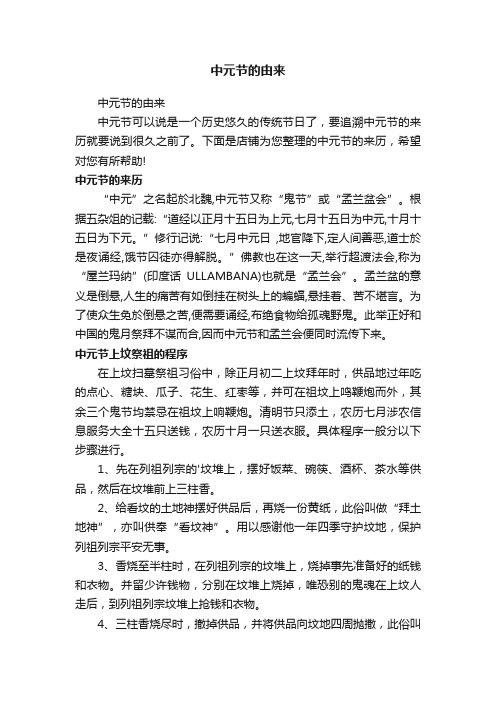
中元节的由来中元节的由来中元节可以说是一个历史悠久的传统节日了,要追溯中元节的来历就要说到很久之前了。
下面是店铺为您整理的中元节的来历,希望对您有所帮助!中元节的来历“中元”之名起於北魏,中元节又称“鬼节”或“孟兰盆会”。
根据五杂俎的记载:“道经以正月十五日为上元,七月十五日为中元,十月十五日为下元。
”修行记说:“七月中元日,地官降下,定人间善恶,道士於是夜诵经,饿节囚徒亦得解脱。
”佛教也在这一天,举行超渡法会,称为“屋兰玛纳”(印度话ULLAMBANA)也就是“孟兰会”。
孟兰盆的意义是倒悬,人生的痛苦有如倒挂在树头上的蝙蝠,悬挂着、苦不堪言。
为了使众生免於倒悬之苦,便需要诵经,布绝食物给孤魂野鬼。
此举正好和中国的鬼月祭拜不谋而合,因而中元节和孟兰会便同时流传下来。
中元节上坟祭祖的程序在上坟扫墓祭祖习俗中,除正月初二上坟拜年时,供品地过年吃的点心、糖块、瓜子、花生、红枣等,并可在祖坟上鸣鞭炮而外,其余三个鬼节均禁忌在祖坟上响鞭炮。
清明节只添土,农历七月涉农信息服务大全十五只送钱,农历十月一只送衣服。
具体程序一般分以下步骤进行。
1、先在列祖列宗的'坟堆上,摆好饭菜、碗筷、酒杯、茶水等供品,然后在坟堆前上三柱香。
2、给看坟的土地神摆好供品后,再烧一份黄纸,此俗叫做“拜土地神”,亦叫供奉“看坟神”。
用以感谢他一年四季守护坟地,保护列祖列宗平安无事。
3、香烧至半柱时,在列祖列宗的坟堆上,烧掉事先准备好的纸钱和衣物。
并留少许钱物,分别在坟堆上烧掉,唯恐别的鬼魂在上坟人走后,到列祖列宗坟堆上抢钱和衣物。
4、三柱香烧尽时,撤掉供品,并将供品向坟地四周抛撒,此俗叫做“拜四方”。
意思是给那些人去上坟的远亲近邻抛撒吃的,不让他们在上坟人走后,到列祖列宗的坟堆上抢吃的。
上坟应该注意哪些细节?扫墓时穿黑色衣服庄重肃穆,可以表达对先人的哀思,扫墓时反而不宜穿大红大绿的衣服,这种衣服与扫墓的气氛不协调,还是穿素色衣服比较适宜。
中元节的来历中英文
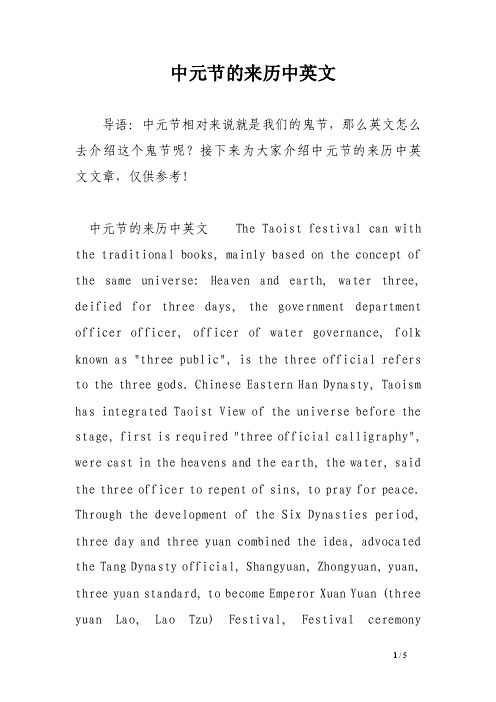
中元节的来历中英文导语:中元节相对来说就是我们的鬼节,那么英文怎么去介绍这个鬼节呢?接下来为大家介绍中元节的来历中英文文章,仅供参考!中元节的来历中英文 The Taoist festival can with the traditional books, mainly based on the concept of the same universe: Heaven and earth, water three, deified for three days, the government department officer officer, officer of water governance, folk known as "three public", is the three official refers to the three gods. Chinese Eastern Han Dynasty, Taoism has integrated Taoist View of the universe before the stage, first is required "three official calligraphy", were cast in the heavens and the earth, the water, said the three officer to repent of sins, to pray for peace. Through the development of the Six Dynasties period, three day and three yuan combined the idea, advocated the Tang Dynasty official, Shangyuan, Zhongyuan, yuan, three yuan standard, to become Emperor Xuan Yuan (three yuan Lao, Lao Tzu) Festival, Festival ceremonyparticipation rate Baiguan emperor. Since Tang and Song Dynasties, it has become a folk festival.道教节日能与传统民书相应,主要基于同一宇宙观:即天、地、水三界,被神格化为天官、地官、水官所统辖的三界府署,民间通称的"三界公",便是以三官泛指三界众神。
初中介绍中元节的英语作文

初中介绍中元节的英语作文English: The mid-year festival, also known as the Hungry Ghost Festival, is a traditional Chinese festival celebrated on the fifteenth day of the seventh lunar month. It is believed that during this time, the gates of the underworld are opened and the spirits of the deceased are free to roam the earth. To honor and appease these spirits, people offer food, burn incense, and perform various rituals. One of the most common customs is to set up an altar for the spirits and make offerings of food, drinks, and other necessities. In addition, elaborate paper-mâché figures are also crafted and burned as offerings to the spirits. The festival is also marked by various performances, such as traditional Chinese opera and puppet shows, as well as the release of paper lanterns and boats onto rivers and lakes to guide the spirits back to the underworld.中文翻译: 中元节,又称鬼节,是中国的传统节日,庆祝时间是农历七月十五日。
中元节的来历和禁忌介绍
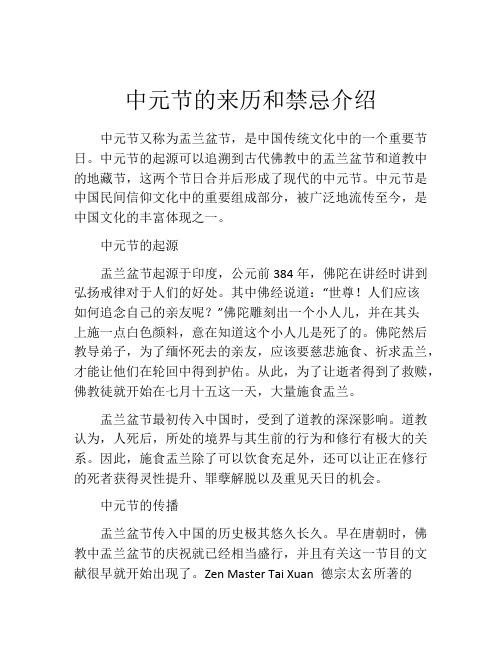
中元节的来历和禁忌介绍中元节又称为盂兰盆节,是中国传统文化中的一个重要节日。
中元节的起源可以追溯到古代佛教中的盂兰盆节和道教中的地藏节,这两个节日合并后形成了现代的中元节。
中元节是中国民间信仰文化中的重要组成部分,被广泛地流传至今,是中国文化的丰富体现之一。
中元节的起源盂兰盆节起源于印度,公元前384年,佛陀在讲经时讲到弘扬戒律对于人们的好处。
其中佛经说道:“世尊!人们应该如何追念自己的亲友呢?”佛陀雕刻出一个小人儿,并在其头上施一点白色颜料,意在知道这个小人儿是死了的。
佛陀然后教导弟子,为了缅怀死去的亲友,应该要慈悲施食、祈求盂兰,才能让他们在轮回中得到护佑。
从此,为了让逝者得到了救赎,佛教徒就开始在七月十五这一天,大量施食盂兰。
盂兰盆节最初传入中国时,受到了道教的深深影响。
道教认为,人死后,所处的境界与其生前的行为和修行有极大的关系。
因此,施食盂兰除了可以饮食充足外,还可以让正在修行的死者获得灵性提升、罪孽解脱以及重见天日的机会。
中元节的传播盂兰盆节传入中国的历史极其悠久长久。
早在唐朝时,佛教中盂兰盆节的庆祝就已经相当盛行,并且有关这一节目的文献很早就开始出现了。
Zen Master Tai Xuan 德宗太玄所著的《庚申杂记》,就是唐朝记录盂兰盆节的一本书。
李白的《春园柳·杂言》,也记载了盂兰盆节的场景。
到了宋朝的时候,盂兰盆节已经逐渐形成了中国社会中独立的仪式。
这一传统由于秦时的焚书坑儒和后世的文化大革命期间一度被封杀。
但是由于人们在不同层面上都具有对祖先仰慕的信仰,因此这种传统事实上并没有消失。
当盂兰盆节在今天重新复苏时,已经与传统道教、佛教信仰不同,更多地与祭祖、祭先人由来已久的中国习俗联系在一起。
有关中元节的传说和记载也更多地反映了这种联系。
中元节的禁忌除了庆祝和祭祖,中元节也有一些禁忌需要注意。
这是基于中元节的与祖先有关的性质,一些习俗也在其中起到了重要的角色。
以下是中元节的一些禁忌:第一、不要在晚上外出,晚上行动会让鬼神更加容易寄宿与人。
中元节英文简介-The Ghost Festival
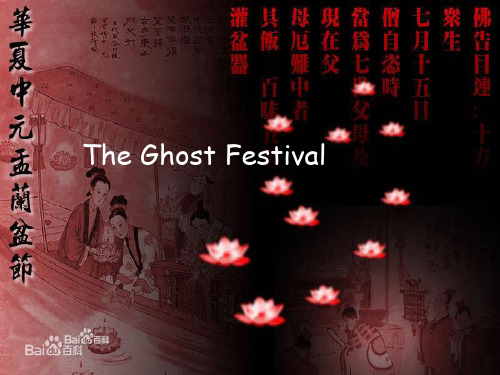
1.A brief introduction 2.The origin of the Ghost Festival 3.Main activities
In Chinese tradition, the fifteenth day (in someplace of south China it is the fourteenth day)of the seventh month in the lunar calendar is called the Ghost Festival, and the seventh lunar month in general is regarded as the Ghost Month, in which ghosts and spirits, including those of the deceased ancestors, come out from the lower realm。In Taoism this festival is also called "Zhongyuan Festival",and in Buddism it is called "Obon Festival". It is also called"the Mid-July day" among Chinese people. It is believed during the seventh lunar month, the gates of hell are thrown open, releasing hungry ghosts to wander the earth in search of food and taking revenge upon those who wronged them in life. So this festival is also called " the Hungry Ghost Festival ".
中元节的英文介绍作文

中元节的英文介绍作文中元节的英文介绍作文在日常学习、工作和生活中,大家最不陌生的就是作文了吧,写作文可以锻炼我们的独处习惯,让自己的心静下来,思考自己未来的.方向。
那么你知道一篇好的作文该怎么写吗?下面是小编帮大家整理的中元节的英文介绍作文,仅供参考,欢迎大家阅读。
The Ghost Festival, also known as the Hungry Ghost Festival, is a traditional Chinese festival and holiday celebrated by Chinese in many countries. In the Chinese calendar (a lunisolar calendar), the Ghost Festival is on the 15th night of the seventh lunar month (14th in southern China).In Chinese tradition, the fifteenth day of the seventh month in the lunar calendar is called Ghost Day and the seventh month in general is regarded as the Ghost Month (鬼月), in which ghosts and spirits, including those of the deceased ancestors, come out from the lower realm. Distinct from both the Qingming Festival (in Spring) and Chung Yeung Festival (in Autumn) in which living descendants pay homage to their deceased ancestors, on Ghost Day, the deceased are believed to visit the living.On the fifteenth day the realms of Heaven and Hell and the realm of the living are open and both Taoists and Buddhists would perform rituals to transmute and absolve the sufferings of the deceased. Intrinsic to the Ghost Month is ancestor worship, where traditionally the filial piety of descendants extends to their ancestors even after their deaths. Activities during the month would include preparing ritualistic food offerings, burning incense, and burning joss paper, a papier-mché form of material items such as clothes, gold and other fine goods for the visiting spirits of the ancestors. Elaborate meals (often vegetarian meals)would be served with empty seats for each of the deceased in the family treating the deceased as if they are still living. Ancestor worship is what distinguishes Qingming Festival from Ghost Festival because the latter includes paying respects to all deceased, including the same and younger generations, while the former only includes older generations. Other festivities may include, buying and releasing miniature paper boats and lanterns on water, which signifies giving directions to the lost ghosts and spirits of the ancestors and other deities.The Ghost Festival is celebrated during the seventh month of the Chinese calendar. It also falls at the same time as a full moon, the new season, the fall harvest, the peak of Buddhist monastic asceticism, the rebirth of ancestors, and the assembly of the local community. During this month, the gates of hell are opened up and ghosts are free to roam the earth where they seek food and entertainment. These ghosts are believed to be ancestors of those who forgot to pay tribute to them after they died, or those who were never given a proper ritual send-off. They have long needle-thin necks because they have not been fed by their family, or as a punishment so that they are unable to swallow. Family members offer prayers to their deceased relatives, offer food and drink and burn hell bank notes and other forms of joss paper. Joss paper items are believed to have value in the afterlife,considered to be very similar in some aspects to the material world, People burn paper houses, cars, servants and televisions to please the ghosts. Families also pay tribute to other unknown wandering ghosts so that these homeless souls do not intrude on their lives and bring misfortune. A large feast is held for the ghosts on the fourteenth day of the seventh month, when people brings samples of food and places them on an offeringtable to please the ghosts and ward off bad luck.In some East Asian countries today, live performances are held and everyone is invited to attend. The first row of seats are always empty as this is where the ghosts sit. The shows are always put on at night and at high volumes as the sound is believed to attract and please the ghosts. Some shows include Chinese opera, dramas, and in some areas, even burlesque shows. These acts are better known as "Merry-making".For rituals, Buddhists and Taoists hold ceremonies to relieve ghosts from suffering, many of them holding ceremonies in the afternoon or at night (as it is believed that the ghosts are released from hell when the sun sets). Altars are built for the deceased and priests and monks alike perform rituals for the benefit of ghosts. Monks and priests often throw rice or other small foods into the air in all directions to distribute them to the ghosts.During the evening, incense is burnt in front of the doors households. Incense stands for prosperity in Chinese culture, so families believe that there is more prosperity in burning more incense.[4]During the festival, some shops are closed as they want to leave the streets open for the ghosts. In the middle of each street stands an altar of incense with fresh fruit and sacrifices displayed on it.Fourteen days after the festival, to make sure all the hungry ghosts find their way back to hell, people flow water lanterns and set them outside their houses (a practice that can be found amongst the Japanese during Obon). These lanterns are made by setting a lotus flower-shaped lantern on a paper boat. The lanterns are used to direct the ghosts back to the underworld, and when they go out, it symbolizes that they have found their way back.。
浅析如何用英文讲述中元节起源与习俗

浅析如何用英文讲述中元节起源与习俗今天是农历七月十五日,恰好是“中元节”,俗称鬼节,那你知道如何用英文讲述中元节的来源与习俗吗?中文大家肯定都知道,今天小编在此与大家分享如何用英文讲述中元节的来源与习俗,大家不妨来了解下中英对照吧。
【词汇】Hungry Ghost Festival 中元节(也叫“鬼节”)The Hungry Ghost Festival is celebrated on the 15th day of the seventh lunar month.中元节在农历七月十五日。
【中元节的起源】The origin of the Hungry Ghost Festival and the Ghost Month in China is uncertain. Cultures in Asia from India to Cambodia to Japan share similar beliefs about the month, and these traditions seem to date from before Buddha.中元节是否起源于中国并不确定。
关于该节日的文化在一些亚洲国家诸如印度、柬埔寨、日本都信奉着相似的信仰,似乎这些传统都起源于佛教。
According to Taoism, the gates of hell are opened on the first day of the seventh month, and hungry ghosts are released to find food or to take revenge on those who have behaved badly according to Taoist records.根据道教说法,农历七月的第一天地狱之门将打开,饥饿的鬼魂得以释放去寻找食物或报复那些道家记载的作恶多端的人。
【中元节习俗】Family members offer prayers to their deceased relatives, offer food and drink and burn hell bank notes and other forms of joss paper.家庭成员向已故的亲人祈祷,送上祝福,奉上食物和饮料,烧一些诸如冥币这样的纸钱给他们。
河南中元节的来历和风俗作文

河南中元节的来历和风俗作文The Zhongyuan Festival, also known as the Hungry Ghost Festival, is a traditional Chinese festival that falls on the fifteenth day of the seventh lunar month. This festival has a long history and is widely celebrated in many regions of China.中元节,又称为鬼节,是一个传统的中国节日,落在农历七月十五。
这个节日有悠久的历史,在中国许多地区广泛庆祝。
The origin of the Zhongyuan Festival can be traced back to ancient China, where it was believed that the spirits of the deceased were allowed to return to the mortal world during this time. To honor and appease these spirits, people would perform various rituals and offer food and other items to provide for them in the afterlife.中元节的来历可以追溯到古代中国,在那个时候人们相信逝者的灵魂在这个时候得到释放,可以返回人世。
为了尊敬和安抚这些灵魂,人们会进行各种仪式,并供奉食物和其他物品,以供养他们在来世。
One of the most well-known customs of the Zhongyuan Festival is the act of burning joss paper or money. This is done as a way to provide the spirits with material possessions in the afterlife. Peoplealso light incense and candles to guide the spirits back to the underworld after their visit to the mortal world.中元节最著名的风俗之一是烧纸钱。
中元节是什么节日由来以及介绍大全

中元节是什么节日由来以及介绍大全每年的农历7月15日是中元节,那么中元节是什么节,中元节的来历,中元节都有哪些习俗?下面给大家分享关于中元节是什么节日由来以及介绍大全2021,欢迎阅读!中元节的由来“中元”之名起於北魏,中元节又称“鬼节”或“孟兰盆会”。
根据五杂俎的记载:“道经以正月十五日为上元,七月十五日为中元,十月十五日为下元。
”修行记说:“七月中元日,地官降下,定人间善恶,道士於是夜诵经,饿节囚徒亦得解脱。
”佛教也在这一天,举行超渡法会,称为“屋兰玛纳”(印度话ULLAMBANA)也就是“孟兰会”。
孟兰盆的意义是倒悬,人生的痛苦有如倒挂在树头上的蝙蝠,悬挂著、苦不堪言。
为了使众生免於倒悬之苦,便需要诵经,布绝食物给孤魂野鬼。
此举正好和中国的鬼月祭拜不谋而合,因而中元节和孟兰会便同时流传下来。
中元节的传说有关中元节的传说很多,最主要的有—阎罗王於每年农历七月初一,打开鬼门关,放出一批无人奉祀的孤魂野鬼到阳间来享受人们的供祭。
七月的最后一天,重关鬼门之前,这批孤魂野鬼又得返回阴间。
所以七月又称鬼月。
目莲救母的故事:佛陀弟子中,神通第一的目犍莲尊者,惦念过世的母亲,他用神通看到其母因在世时的贪念业报,死后堕落在的恶鬼道,过著吃不饱的生活。
目犍莲於是用他的神力化成食物,送给他的母亲,但其母不改贪念,见到食物到来,深怕其他恶鬼抢食,贪念一起食物到她口中立即化成火炭,无法下咽。
目犍莲虽有神通,身为人子,却救不了其母,十分痛苦,请教佛陀如何是好。
佛陀说:“七月十五日是结夏安居修行的最后一日,法善充满,在这一天,盆罗百味,供巷僧众,功德无量,可以凭此慈悲心,救渡其亡母。
”这便是台湾普渡拜“好兄弟”的由来。
每年农历七月十五日为“盂兰盆节”,也称“中元节”有些地方又州俗称“鬼节”,“施孤”。
本是印度一种佛教仪式。
佛教徒为了追荐祖先举行“盂兰盆会”;佛经中《盂兰盆经》以修孝顺励佛弟子的旨意,合乎中国追先悼远的俗信,于是益加普及。
中元节的风俗450字左右作文

中元节的风俗450字左右作文英文回答:The Mid-Autumn Festival, also known as Zhong Yuan Jie in Chinese, is a traditional festival celebrated by Chinese people around the world. It falls on the 15th day of the8th month in the Chinese lunar calendar, which is usually in September or early October in the Gregorian calendar.During the Mid-Autumn Festival, people gather withtheir families to appreciate the full moon and eat mooncakes. Mooncakes are a traditional Chinese pastryfilled with lotus seed paste, red bean paste, or salted egg yolk. They are often given as gifts to friends and family members as a symbol of reunion and good wishes.Another popular custom during the Mid-Autumn Festival is carrying brightly lit lanterns and parading through the streets. This tradition is especially popular among children, who enjoy the colorful and decorative lanterns.In addition to lantern parades, there are also various cultural performances and activities held in many communities to celebrate the festival.The Mid-Autumn Festival is also a time for people topay respects to their ancestors. Many families visit the graves of their loved ones to clean the tombs, offer food and incense, and pay their respects. This is based on the belief in Chinese culture that the spirits of the deceased return to the human world during the festival.Overall, the Mid-Autumn Festival is a time for family reunions, expressing gratitude, and celebrating the harvest. It is a cherished tradition that has been passed down through generations and continues to be an important partof Chinese culture.中文回答:中元节,又称中秋节,是中国人民世界各地庆祝的传统节日。
双语:中国四大鬼节之一七月半或中元节英语介绍

双语:中国四大鬼节之一七月半或中元节英语介绍万圣节是西方的鬼节,那你知道中国的四大鬼节是那四个节日吗?今天介绍中国四大鬼节之一七月半,俗称鬼节,又称中元节或盂兰盆节。
民间有阳间过元宵节阴间过鬼节的传说,因此鬼节是阴间最大的节日。
你知道怎样向外国朋友介绍中国的鬼节吗?随小编一起来看看吧!There are many ghosts in Chinese culture; they have been worshipped by the Chinese for a few thousand years. Even Confucius said, "Respect ghosts and gods, but keep away from them."While many people believe in ghosts, there are others who don't. The Chinese people often say, "If you believe it, there will be, but if you don't, there will not."The ghost is a classical image in Chinese culture, i.e., the young woman whose face is covered by long black hair, who dies due to misfortune, then comes back for revenge.The word "ghost" for many Chinese conjures up similar images. Often the ghost is a beautiful young woman. The sudden switch from a beautiful girl to a frightening ghost is striking. The seemingly fragile, helpless and beautiful women turning into fearless killers is a favorite theme among Asian movie directors and storywriters.Chinese Ghost FestivalJust as the West features Halloween for ghosts and ghouls, the Chinese have a holiday to honor the departed spirits of the underworld -- the Chinese Ghost Festival. It is said that ghosts roam the world every year for one lunar month. In some areas of China, visitors can see small roadside fires, where believers burn paper money and other offerings to appease the restless spiritsthat have temporarily been released from Hades.The Chinese Ghost Festival is also called "Half July" (Lunar). It is a popular occasion celebrated throughout China on the 15th day of the seventh lunar month.Historically, families offer sacrifices of the newly harvested grain to departed ancestors on this day, which also coincides with the Buddhist Ullambana (Deliverance) Festival and the Taoist Chinese Ghost Festival. Since each of these traditions in some way honors the spirits of the departed, the seventh lunar month has come to be known as "Ghost Month" and is a time when the "Good Brethren" (ghosts from the underworld) come back to earth to feast on the victuals offered by the living. Over time the Ullambana Festival and Ghost Festival have melded together to become the present-day Chung Yuan Putu or "Mid-origin Passage to Universal Salvation."The Chinese believe that the dead become ghosts between heaven and earth. Spirits without descendants to care for them are summoned during the Ghost Festival so that they may also enjoy the warmth of life among the living. This custom -- an extension of the traditional Chinese ethic of "universal love" -- has been woven together with the didactic legend, "Moginlin Saving His Mother From Hades." It lends the Ghost Festival a positive spin as a time for remembering the importance of filial piety. People now have inherited releasing river light as an important activity. It is said that river light can comfort and warm homeless ghosts.Burial of the deadIn the past, the burial of the dead (cremation is traditionally uncommon) was a matter taken very seriously in Chinese society. Improper funeral arrangements could wreak ill fortune anddisaster upon the family of the deceased.To a certain degree, Chinese funeral rites and burial customs were determined by the age of the deceased, the manner of his/her death, his/her status and position in society and his/her marital status.According to Chinese custom, an older person should not show respect to someone younger. Thus, if the deceased was a young bachelor his body could not be brought home but was left at the funeral parlor and the parents could not offer prayers for their son. Since the deceased was unmarried he had no children to perform the rites, which was why the body did not enter the family home. If a baby or child died no funeral rites were performed since respect could not be shown to a younger person. The child was, therefore, buried in silence.Chinese funeral rites for an elderly person must follow the prescribed form and convey the relevant rites that befit the person.Chinese thoughts towards life after deathYoung women in traditional societies are rarely endowed with much power, and malignant powers are only summoned with keen hatred and a desire for revenge. The more badly one is wronged, the more powerful he or she becomes after death.Such beliefs are closely related to the Chinese attitude towards life after death -- a combination of superstition and religion.Buddhist doctrines about the life cycle led to many vivid descriptions in Chinese legends about karma. For example, Buddhism forbids murder; in folklore, people believe that butchers return in the next life in the form of the animals they killed. People who treat others badly or do cruel things becomepathetic beings, suffering for the rest of the next life.Besides retribution in lives to come, vivid and complicated descriptions of heaven and hell also exist in Chinese legends.People have imaginatively transfigured their real life experiences into visions of the unknown world. The Chinese legendary hell, for example, is governed by a king in a completely bureaucratic system.The king of the underground takes charge of people's lives, keeping a book that spells out the exact time of everybody's death.In the classic novel, Pilgrimage to the West, the Monkey King Wu Kong goes to visit the king of hell and reads the book of death. He looks for his own name and erases it, ensuring himself everlasting life.。
中元节英文介绍

中元节英文介绍The Mid-Autumn Festival, also known as Zhongqiu Festival in Chinese, is a traditional Chinese festival that is held on the 15th day of the 8th lunar month, which usually falls in September or early October. It is a time for family reunions and the celebration of harvest.The festival has a long history, dating back more than 3,000 years. It was originally a harvest festival, where people would give thanks for the good harvest and pray for a better future. The festival is also closely associated with the moon and its worship. The full moon during the Mid-Autumn Festival is considered to be the brightest and roundest of the year, symbolizing unity and completeness.One of the most important traditions of the Mid-Autumn Festival is the eating of mooncakes. Mooncakes are round pastries filled with various sweet or savory fillings, such as lotus seed paste, red bean paste, or egg yolk. They are usually enjoyed with a cup of tea or a glass of wine. In addition to mooncakes, people also enjoy fruits, nuts, and other traditional delicacies during the festival.Another popular activity during the Mid-Autumn Festival is lantern making and lantern parades. Children and adults alike enjoy making and decorating lanterns in various shapes and sizes. These lanterns are then displayed and paraded in the streets at night, creating a colorful and festive atmosphere.During the festival, families and friends also gather to appreciate the moon. They sit outside, often on rooftops or in gardens, andadmire the beauty of the moon while enjoying mooncakes and tea. In some regions, there are even special performances, such as traditional dragon and lion dances, to entertain the crowds.The Mid-Autumn Festival is not only celebrated in China, but also in other East Asian countries such as Vietnam, Korea, and Singapore. Each country has its own unique customs and traditions, but the essence of the festival remains the same - to celebrate the harvest, give thanks, and enjoy the company of loved ones.In recent years, the Mid-Autumn Festival has gained popularity worldwide. It has become a time for cultural exchange and celebration, with people from different cultures and backgrounds coming together to experience and share the joy of this ancient festival.In conclusion, the Mid-Autumn Festival is a time for family reunions, the celebration of harvest, and the worship of the moon. It is a festive occasion filled with delicious food, colorful lanterns, and the company of loved ones. Whether you are in China or anywhere else in the world, the Mid-Autumn Festival is a time to come together and appreciate the beauty of nature and the blessings of life.。
中元节(鬼节)的来历与禁忌
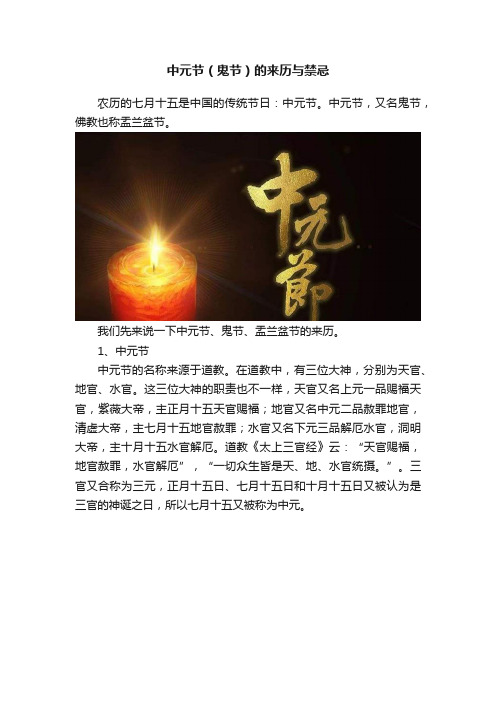
中元节(鬼节)的来历与禁忌农历的七月十五是中国的传统节日:中元节。
中元节,又名鬼节,佛教也称盂兰盆节。
我们先来说一下中元节、鬼节、盂兰盆节的来历。
1、中元节中元节的名称来源于道教。
在道教中,有三位大神,分别为天官、地官、水官。
这三位大神的职责也不一样,天官又名上元一品赐福天官,紫薇大帝,主正月十五天官赐福;地官又名中元二品赦罪地官,清虚大帝,主七月十五地官赦罪;水官又名下元三品解厄水官,洞明大帝,主十月十五水官解厄。
道教《太上三官经》云:“天官赐福,地官赦罪,水官解厄”,“一切众生皆是天、地、水官统摄。
”。
三官又合称为三元,正月十五日、七月十五日和十月十五日又被认为是三官的神诞之日,所以七月十五又被称为中元。
2、鬼节鬼节名称的来历,实际上也跟道教有关,七月在道教里也被称为鬼月。
三元中的地官大帝所管的就是地府,在经书中讲,从农历七月初一起,地府打开鬼门,赦放出鬼魂到人间来接受阳间亲人的祭祀,七月三十日返回。
同时,也是地官大帝校籍众生罪过之时。
在道教的经文典籍和传说中,七月十五之天,地官大帝会拿出众生的薄籍,根据神仙、凡人、动物们的表现,勾画赦罪免刑。
所以到了这一天,太乙救苦天尊也会广开宏恩,大赦地狱,由地官负责赦罪解愆,鬼门大开而慈法普施,广度鬼魂。
所以阳间的生人们,在这一天也会为自己的已故的亲人朋友烧纸祭祀,诵经超度,期待他们在阴时能过的更好。
后来这一日,也就逐渐演变成了祭祀祖先的节日,人们也认为在这一日为已故的人的祭祀物品,他们都可以收到,故这一日也是人们体现孝道的重要节日。
而因为鬼门大开的缘故,所以这一日也被称为鬼节。
3、盂兰盆节盂兰盆节名称的来历,这个名称的来历与佛教有关,在《佛说盂兰盆经》中有这样一个故事:目犍连(佛的十大弟子之一)修行得了六通,就忽然想起了自己已经故去的母亲,于是就想救度自己母亲,报答她的养育之恩,于是就以道眼观看世间。
这一看,了不得了,他死去的母亲,竟然投生到了饿鬼道中受苦,喉咙细小不得饮食,皮骨相连,瘦弱不堪。
七月十五农历中元节,的作文
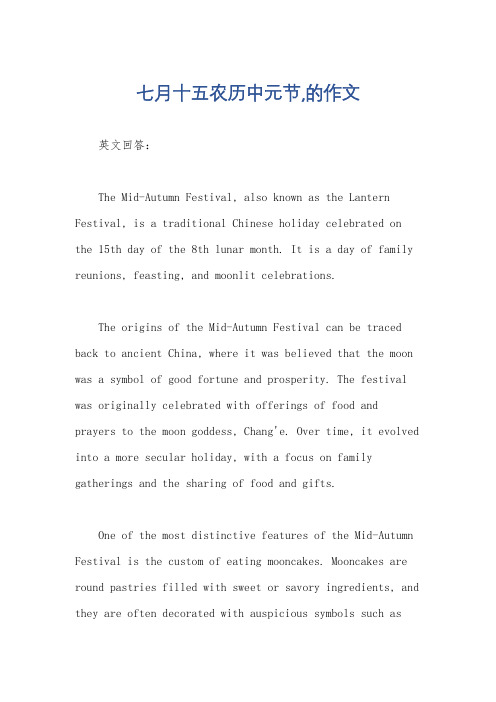
七月十五农历中元节,的作文英文回答:The Mid-Autumn Festival, also known as the Lantern Festival, is a traditional Chinese holiday celebrated on the 15th day of the 8th lunar month. It is a day of family reunions, feasting, and moonlit celebrations.The origins of the Mid-Autumn Festival can be traced back to ancient China, where it was believed that the moon was a symbol of good fortune and prosperity. The festival was originally celebrated with offerings of food and prayers to the moon goddess, Chang'e. Over time, it evolved into a more secular holiday, with a focus on family gatherings and the sharing of food and gifts.One of the most distinctive features of the Mid-Autumn Festival is the custom of eating mooncakes. Mooncakes are round pastries filled with sweet or savory ingredients, and they are often decorated with auspicious symbols such asthe moon, rabbits, and lotus flowers. Mooncakes are traditionally shared among family and friends, and they are believed to bring good luck and prosperity.Another iconic tradition of the Mid-Autumn Festival is the lighting of lanterns. Lanterns are used to decorate homes and streets, and they are often inscribed with good wishes or auspicious symbols. Lanterns are also used to light up the night sky, and they create a magical and festive atmosphere.In addition to mooncakes and lanterns, the Mid-Autumn Festival is also celebrated with a variety of other activities, such as dragon boat races, lion dances, and fireworks displays. These activities are all designed to bring good luck and prosperity, and they add to the festive atmosphere of the holiday.中文回答:七月十五农历中元节,又称为盂兰盆节,是中国传统节日,在农历八月十五日庆祝。
中元节英文介绍(两篇)

中元节英文介绍(两篇)中国的鬼节是中元节哦,过惯了西方万圣节的同学们,不妨一起来过一过中国的鬼节吧!下面是由作文网为您准备的两篇《中元节英文介绍》。
篇一:中元节英文介绍Begins in the name of "yuan" in the northern wei dynasty, is the view of Taoism. According to ancient books: it is on the fifteenth day of the "has", as the cheongwan blessed day; In July 15 is "yuan", for the officer to forgive SINS; October 15 is "yuan" for urban water officer solution. According to the practice to record "records:" ganjitsu in July, the land officer, the world of good and evil, Taoist and night chanting, hungry section prisoner may also liberation." Therefore, in the July 15 this day, folk will prepare rich offering, officer emperor and ancestor worship.Hungry ghost festival is a combination of Taoism and Chinese traditional folk, the corresponding, mainly based on the same world view: heaven, earth, water, permeating the godhead into cheongwan, officer, officer of water permeating the governance by the government agency. Folk known as "three worlds", is in three officer refers to three of the gods.Chinese eastern han dynasty last years, the documents has comprehensive Taoist cosmology, and before the first ever to be on the "three officer calligraphy", respectively, into the heaven, earth, water, and said to three officer sin, repentance to pray for peace. After the development of the six dynasties period, combined with the three days and three yuan in the tang dynasty to the promotion of the official, has, in the yuan, the yuan, and so on three ganjitsu standard, be blessed, najib, ancestor worship, three yuan festival to worship, the emperor rate officials toparticipate in the festival ceremony. After the tang, song, three ganjitsu become a folk festival.The hungry ghost festival, daoist temples, such as outside the gates of fire temples, XiBianMen baiyunguan temple and so on in order to pray the good crop weather, peaceful country and safe people routinely held "blessing propitious dojo" every year. Because of the psychological fear him, people in the daily life of composite of Confucianism, Buddhism, Taoism, the lunar July 15 of the hungry ghost festival known as the ghost festival, called the lunar July "ghost month".After the introduction of Buddhism, Buddhism also has a prayer ancestors, known as the "house," Lamar quin had gone words ULLAMBANA (India), namely "Meng Lan basin will". Meng Lan basin is the meaning of abuse, the pain of life is like a bat hangs on the tree, hanging, suffering. In order to make the living beings from suspension, then need to chant, cloth off food to the wandering soul wild ghost. The move coincided with the Chinese ghost month, worship, and Buddhism is the lunar July 15 turn undead will held on this day, so hungry ghost festival and Meng Lan will come down at the same time.篇二:中元节英文介绍July 15 inclusive festival customs is more complex, is commonly known as the ghost festival, folk and Taoist hungry ghost festival, is also a buddhist obon, is a way, the monk, festival vulgar third-rate unity.According to legend, every year from July 1st lunar month, yama ordered big open the gates of hell, let those who suffer imprison all year round in the ghosts of hell spectre, out of the hell, for short-term wandering, enjoy food, human blood so known as the ghost month, July 14th of July is the day of ghostsdoor open, July 15 is Halloween.According to the logic of Taoism culture, three basic elements, think of all things to feed the world is heaven, earth, water, will be the first half of the year as cheongwan, in the second half is officer. That day to xuan xuan, day, ground water, all things, water is the foundation of the creatures. Taoism virtual cheongwan, three officer, officer, officer of water cheongwan blessed, to forgive SINS, solution of urban water officer. The officer is the jade emperor in the representative of the world, every year to visit the world of good and evil, upward reporting day. Third officer on the 15th, July 15, October 15 for birthday, respectively called has these three days, in dollars and RMB. Call in the July 15 yuan, on this day, to academy is a record of SINS, he took a thick roster, according to the performance of gods, human, animal, award of rewards and punishments, exempt from punishment of SINS. "Hungry ghost festival" reward good and punish the bad not only, also encourage the sin of SINS, who have sin in the hungry ghost festival in a year this day through a variety of yili to accommodate yourself and request of forgiveness.。
中元节的来历和传统习俗

中元节的来历和传统习俗中元节是中国传统的一个重要节日,又称鬼节、盂兰盆节,每年农历七月十五日举行。
中元节是中国传统文化中关于亡灵和鬼魂的节日,是祭祀祖先和神灵的重要日子。
中元节的来历和传统习俗有哪些?下面我们来一探究竟。
一、中元节的来历中元节起源于中国汉朝,主要是为了安抚已故父母和祖先的灵魂,在农历七月十五日这个特殊的日子里,人们要祭祀他们,并用饭、饮料、香烛等物品供奉他们的灵魂。
据传说,盂兰盆节是由佛教创始人释迦牟尼所推崇的,因为它是纪念阿难陀涅槃两周年的节日。
佛教传统认为,人死后的灵魂会到另一个世界,需要家属和后人的供奉来安抚和救赎灵魂。
二、中元节传统习俗1.供奉祖先的祭品中元节的最重要的传统习俗是供奉祖先的祭品。
这些祭品包括香烛、纸钱、酒、饭、果实等,人们会在自家门口摆上供桌,上面放上祭品,以示对已故亲人的尊重和怀念。
此外,人们还会在上面写上祖先的姓名、籍贯等信息,以便他们在阴间能找到他们的后代。
2.放生活动在中元节这一天,人们还有一个重要的传统习俗,就是放生活动。
这种活动主要是为了救助那些被放逐或者被捕捉的虫子和小动物,让他们重新获得自由和生命。
这个传统意义上的放生活动,也是中国人对于物语动物权利及保护生态环境的一种表达。
3.观看《幽灵戏》另一个重要的传统习俗是观看《幽灵戏》。
这是中元节的另一个特色,是一种表演形式,通常以表演者穿着特别衣服,分别扮演各种怪异的角色为主,吸引观众。
演员们常常扮演各种角色,在现场制造出像鬼影般的幻象,使观众感到十分真实。
4.穿传统服饰在中元节这天里,穿传统服饰也是一种常见的活动,穿上传统的华美服装,感受传统文化的乐趣,以及表达对过去的怀念与敬仰。
5.吃中元节的美食在中元节这一天里,各地也会有不同的节日美食,例如:荷叶饭、一品锅、糯米饭等等,都是中元节的节日美食。
总之,中元节是中国传统文化中非常重要的一个节日,它是人民对于亡灵和鬼魂的祭祀和安抚,表达了对前人的怀念和敬仰。
中元节的来历及风俗中英文介绍
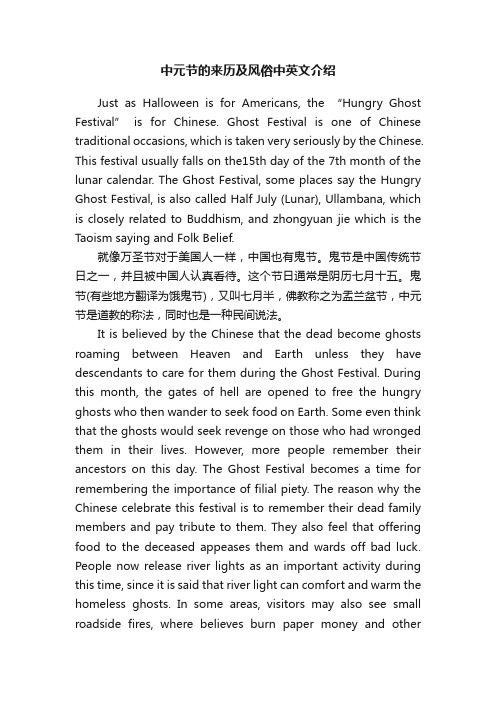
中元节的来历及风俗中英文介绍Just as Halloween is for Americans, the “Hungry Ghost Festival” is for Chinese. Ghost Festival is one of Chinese traditional occasions, which is taken very seriously by the Chinese. This festival usually falls on the15th day of the 7th month of the lunar calendar. The Ghost Festival, some places say the Hungry Ghost Festival, is also called Half July (Lunar), Ullambana, which is closely related to Buddhism, and zhongyuan jie which is the Taoism saying and Folk Belief.就像万圣节对于美国人一样,中国也有鬼节。
鬼节是中国传统节日之一,并且被中国人认真看待。
这个节日通常是阴历七月十五。
鬼节(有些地方翻译为饿鬼节),又叫七月半,佛教称之为盂兰盆节,中元节是道教的称法,同时也是一种民间说法。
It is believed by the Chinese that the dead become ghosts roaming between Heaven and Earth unless they have descendants to care for them during the Ghost Festival. During this month, the gates of hell are opened to free the hungry ghosts who then wander to seek food on Earth. Some even think that the ghosts would seek revenge on those who had wronged them in their lives. However, more people remember their ancestors on this day. The Ghost Festival becomes a time for remembering the importance of filial piety. The reason why the Chinese celebrate this festival is to remember their dead family members and pay tribute to them. They also feel that offering food to the deceased appeases them and wards off bad luck. People now release river lights as an important activity during this time, since it is said that river light can comfort and warm the homeless ghosts. In some areas, visitors may also see small roadside fires, where believes burn paper money and otherofferings to appease the restless spirits who have temporarily been released from Hades.中国人认为除非一个人有子孙后代能够在他死后在鬼节这天悼念他们,否则人死后会变成鬼魂在天地之间游荡。
中元节的来历和禁忌总结
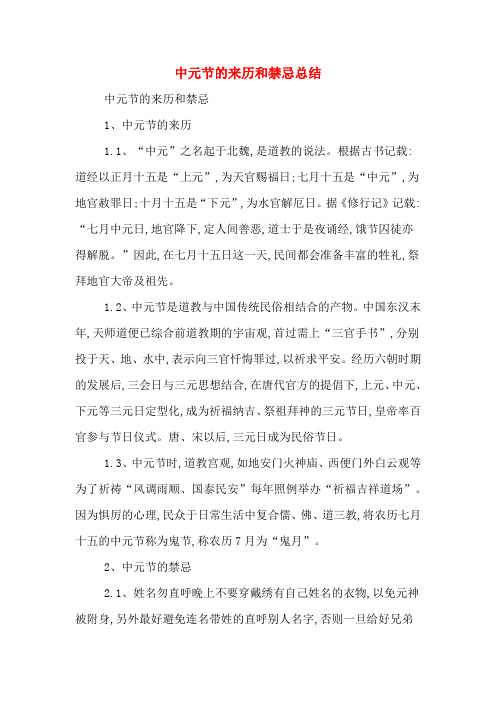
中元节的来历和禁忌总结中元节的来历和禁忌1、中元节的来历1.1、“中元”之名起于北魏,是道教的说法。
根据古书记载:道经以正月十五是“上元”,为天官赐福日;七月十五是“中元”,为地官赦罪日;十月十五是“下元”,为水官解厄日。
据《修行记》记载:“七月中元日,地官降下,定人间善恶,道士于是夜诵经,饿节囚徒亦得解脱。
”因此,在七月十五日这一天,民间都会准备丰富的牲礼,祭拜地官大帝及祖先。
1.2、中元节是道教与中国传统民俗相结合的产物。
中国东汉末年,天师道便已综合前道教期的宇宙观,首过需上“三官手书”,分别投于天、地、水中,表示向三官忏悔罪过,以祈求平安。
经历六朝时期的发展后,三会日与三元思想结合,在唐代官方的提倡下,上元、中元、下元等三元日定型化,成为祈福纳吉、祭祖拜神的三元节日,皇帝率百官参与节日仪式。
唐、宋以后,三元日成为民俗节日。
1.3、中元节时,道教宫观,如地安门火神庙、西便门外白云观等为了祈祷“风调雨顺、国泰民安”每年照例举办“祈福吉祥道场”。
因为惧厉的心理,民众于日常生活中复合儒、佛、道三教,将农历七月十五的中元节称为鬼节,称农历7月为“鬼月”。
2、中元节的禁忌2.1、姓名勿直呼晚上不要穿戴绣有自己姓名的衣物,以免元神被附身,另外最好避免连名带姓的直呼别人名字,否则一旦给好兄弟听到后,会趁机取走他的三魂六魄,同时若听到有人喊自己的名字时,也千万不要立刻回头或回应。
2.2、别拍肩膀从灵学的角度来说,人的身上有三把火,分别在头及两个肩膀上,所以鬼月的时候最好不要随便拍别人的头及肩,以免熄掉他身上的火,让好兄弟有机可乘。
2.3、不可吹口哨,当心好兄弟喜欢你;经过坟地时,口中要不断默念“对不起,打扰了!”并保持肃穆不可吹口哨,以表示对好兄弟的尊重。
2.4、不可去危险水域戏水,传说中“水鬼”会找人当替死鬼,以便投胎。
2.5、不可偷吃祭拜的祭品,与鬼争食,恐遭来厄运。
中元节双语
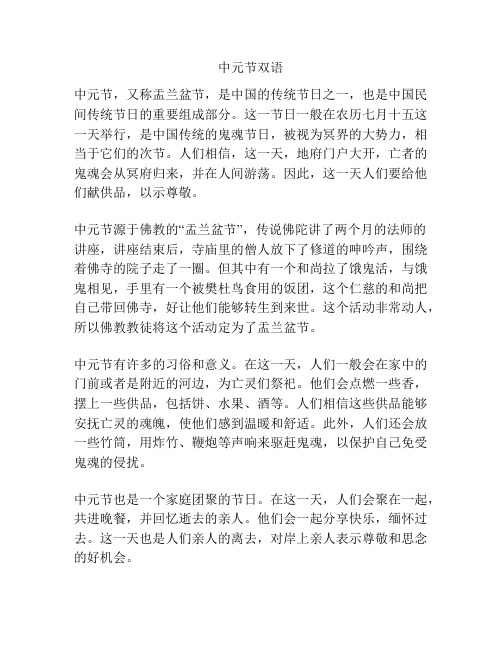
中元节双语中元节,又称盂兰盆节,是中国的传统节日之一,也是中国民间传统节日的重要组成部分。
这一节日一般在农历七月十五这一天举行,是中国传统的鬼魂节日,被视为冥界的大势力,相当于它们的次节。
人们相信,这一天,地府门户大开,亡者的鬼魂会从冥府归来,并在人间游荡。
因此,这一天人们要给他们献供品,以示尊敬。
中元节源于佛教的“盂兰盆节”,传说佛陀讲了两个月的法师的讲座,讲座结束后,寺庙里的僧人放下了修道的呻吟声,围绕着佛寺的院子走了一圈。
但其中有一个和尚拉了饿鬼活,与饿鬼相见,手里有一个被樊杜鸟食用的饭团,这个仁慈的和尚把自己带回佛寺,好让他们能够转生到来世。
这个活动非常动人,所以佛教教徒将这个活动定为了盂兰盆节。
中元节有许多的习俗和意义。
在这一天,人们一般会在家中的门前或者是附近的河边,为亡灵们祭祀。
他们会点燃一些香,摆上一些供品,包括饼、水果、酒等。
人们相信这些供品能够安抚亡灵的魂魄,使他们感到温暖和舒适。
此外,人们还会放一些竹筒,用炸竹、鞭炮等声响来驱赶鬼魂,以保护自己免受鬼魂的侵扰。
中元节也是一个家庭团聚的节日。
在这一天,人们会聚在一起,共进晚餐,并回忆逝去的亲人。
他们会一起分享快乐,缅怀过去。
这一天也是人们亲人的离去,对岸上亲人表示尊敬和思念的好机会。
中元节在中国各地都有一些不同的庆祝方式,但它们的目的和意义都是相同的。
这个节日不仅有着深厚的宗教意义,而且也是民众家庭观念和家庭团聚的重要象征。
中元节是中国人重视敬祖的传统,也是中华民族文化的重要组成部分。
通过这个节日,人们表达了对先人的感激和思念,并展示了中国人民的亲情和传统价值观。
- 1、下载文档前请自行甄别文档内容的完整性,平台不提供额外的编辑、内容补充、找答案等附加服务。
- 2、"仅部分预览"的文档,不可在线预览部分如存在完整性等问题,可反馈申请退款(可完整预览的文档不适用该条件!)。
- 3、如文档侵犯您的权益,请联系客服反馈,我们会尽快为您处理(人工客服工作时间:9:00-18:30)。
中元节的来历及风俗中英文介绍
Just as Halloween is for Americans, the “Hungry Ghost Festival”is for Chinese. Ghost Festival is one of Chinese traditional occasions, which is taken very seriously by the Chinese. This festival usually falls on the15th day of the 7th month of the lunar calendar. The Ghost Festival, some places say the Hungry Ghost Festival, is also called Half July (Lunar), Ullambana, which is closely related to Buddhism, and zhongyuan jie which is the Taoism saying and Folk Belief.
就像万圣节对于美国人一样,中国也有鬼节。
鬼节是中国传统节日之一,并且被中国人认真看待。
这个节日通常是阴历七月十五。
鬼节(有些地方翻译为饿鬼节),又叫七月半,佛教称之为盂兰盆节,中元节是道教的称法,同时也是一种民间说法。
It is believed by the Chinese that the dead become ghosts roaming between Heaven and Earth unless they have descendants to care for them during the Ghost Festival. During this month, the gates of hell are opened to free the hungry ghosts who then wander to seek food on Earth. Some even think that the ghosts would seek revenge on those who had wronged them in their lives. However, more people remember their ancestors on this day. The Ghost Festival becomes a time for remembering the importance of filial piety. The reason why the Chinese celebrate this festival is to remember their dead family members and pay tribute to them. They also feel that offering food to the deceased appeases them and wards off bad luck. People now release river lights as an important activity during this time, since it is said that river light can comfort and warm the homeless ghosts. In some areas, visitors may also see small roadside fires, where believes burn paper money and other offerings to appease the restless spirits who have temporarily been released from Hades.
中国人认为除非一个人有子孙后代能够在他死后在鬼节这天悼念他们,否则人死后会变成鬼魂在天地之间游荡。
在七月,地狱的大门会打开放出饿鬼,这些饿鬼会在凡间寻找食物。
一些人更认为他们会向那些害死他们的人复仇。
但是,更多的人在这一天祭奠他们的先人。
鬼节成为一个子女对先人尽孝的节日。
中国人庆祝这个节日的原因是纪念他们家中死去的成员并且悼念死者。
他们相信祭品能安抚死者,消除厄运。
放河灯是人们纪念鬼节的重要活动,因为据说河灯能给无家可归的孤魂野鬼以慰藉和温暖。
在一些地区,外来者会看见路边一小堆一小堆的火,因为人们相信烧纸钱或其它东西能安抚刚从地狱出来的痛苦幽魂。
